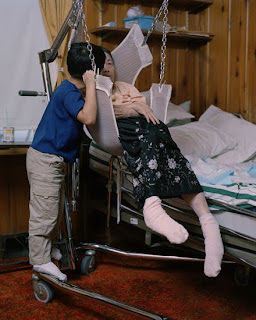


and from Qin Fen, also in Elyria










Cryonics Institute
Clinton Township, Michigan This cryopreservation unit holds the bodies of Rhea and Elaine Ettinger, the mother and first wife of cryonics pioneer, Robert Ettinger. Robert, author of “The Prospect of Immortality” and “Man into Superman” is still alive.
The Cryonics Institute offers cryostasis (freezing) services for individuals and pets upon death. Cryostasis is practiced with the hope that lives will ultimately be extended through future developments in science, technology, and medicine. When, and if, these developments occur, Institute members hope to awake to an extended life in good health, free from disease or the aging process. Cryostasis must begin immediately upon legal death. A person or pet is infused with ice-preventive substances and quickly cooled to a temperature where physical decay virtually stops. The Cryonics Institute charges $28,000 for cryostasis if it is planned well in advance of legal death and $35,000 on shorter notice.


White Tiger (Kenny), Selective Inbreeding
Turpentine Creek Wildlife Refuge and Foundation
Eureka Springs, Arkansas In the United States, all living white tigers are the result of selective inbreeding to artificially create the genetic conditions that lead to white fur, ice-blue eyes and a pink nose. Kenny was born to a breeder in Bentonville, Arkansas on February 3, 1999. As a result of inbreeding, Kenny is mentally retarded and has significant physical limitations. Due to his deep-set nose, he has difficulty breathing and closing his jaw, his teeth are severely malformed and he limps from abnormal bone structure in his forearms. The three other tigers in Kenny’s litter are not considered to be quality white tigers as they are yellow coated, cross-eyed, and knock-kneed.

U.S. Customs and Border Protection, Contraband Room
John F. Kennedy International Airport
Queens, New York African cane rats infested with maggots, African yams (dioscorea), Andean potatoes, Bangladeshi cucurbit plants, bush meat, cherimoya fruit, curry leaves (murraya), dried orange peels, fresh eggs, giant African snail, impala skull cap, jackfruit seeds, June plum, kola nuts, mango, okra, passion fruit, pig nose, pig mouths, pork, raw poultry (chicken), South American pig head, South American tree tomatoes, South Asian lime infected with citrus canker, sugar cane (poaceae), uncooked meats, unidentified sub tropical plant in soil.
All items in the photograph were seized from the baggage of passengers arriving in the U.S. at JFK Terminal 4 from abroad over a 48-hour period. All seized items are identified, dissected, and then either ground up or incinerated. JFK processes more international passengers than any other airport in the United States.

The Central Intelligence Agency, Art
CIA Original Headquarters Building
Langley, Virginia The Fine Arts Commission of the CIA is responsible for acquiring art to display in the Agency’s buildings. Among the Commission’s curated art are two pieces (pictured) by Thomas Downing, on long-term loan from the Vincent Melzac collection. Downing was a member of the Washington Color School, a group of post World War II painters whose influence helped to establish the city as a center for arts and culture. Vincent Melzac was a private collector of abstract art and the Administrative Director of the Corcoran Gallery of Art, Washington D.C.’s premiere art museum.
Since the founding of the CIA in 1947, the Agency has participated in both covert and public cultural diplomacy efforts throughout the world. It is speculated that some of the CIA’s involvement in the arts was designed to counter Soviet Communism by helping to popularize what it considered pro-American thought and aesthetic sensibilities. Such involvement has raised historical questions about certain art forms or styles that may have elicited the interest of the Agency, including abstract expressionism.










